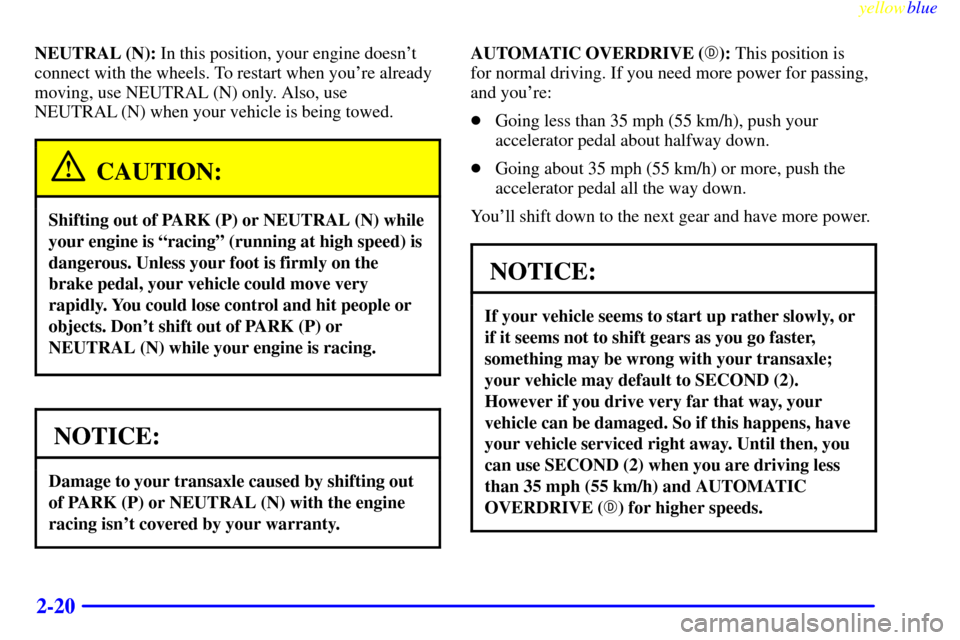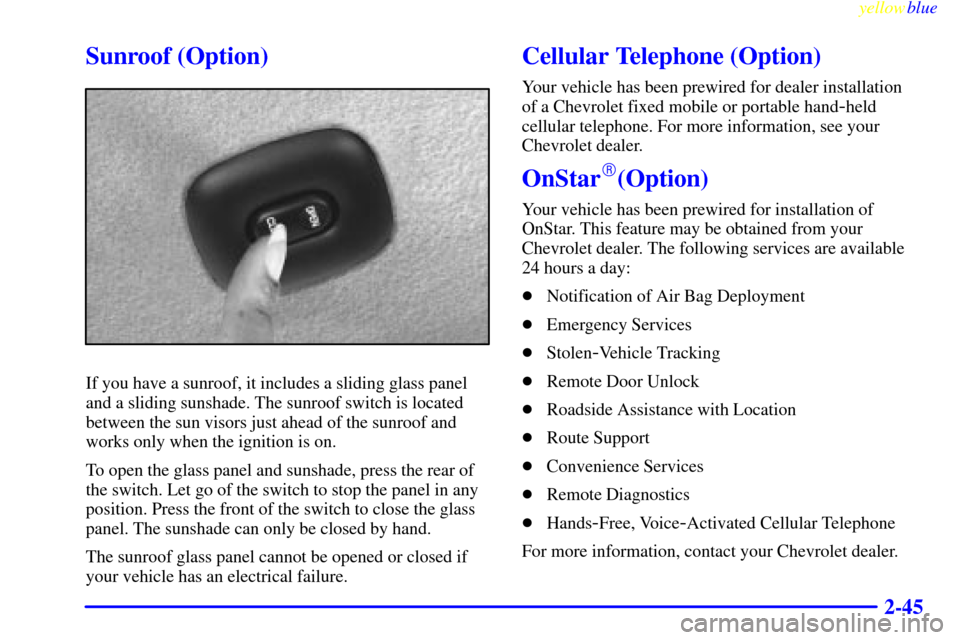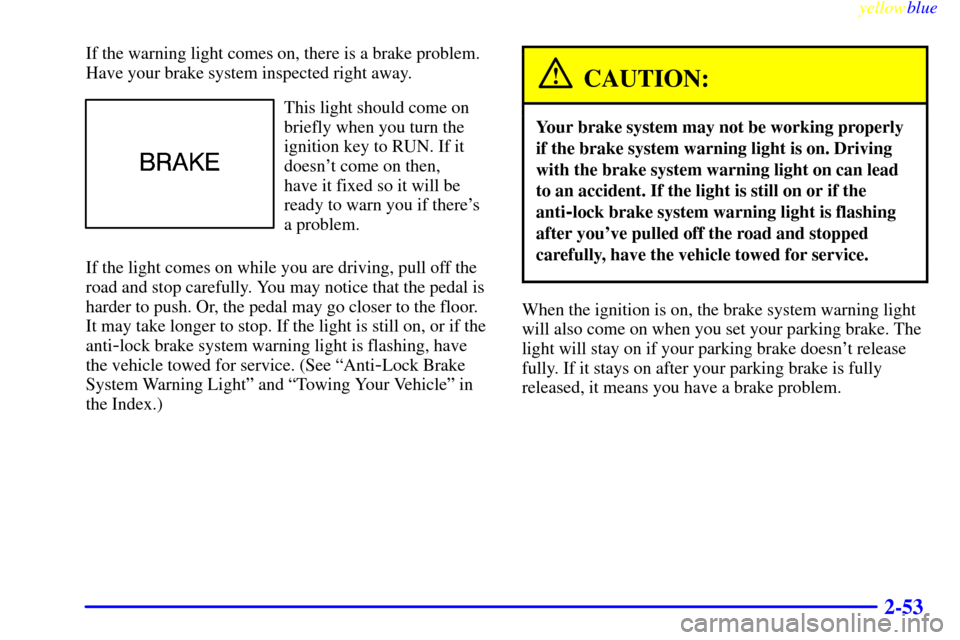Page 74 of 336

yellowblue
2-14
With the ignition key in the ignition switch, you can turn
the switch to five positions.
ACC (A): The accessory position lets you use things
like the radio and windshield wipers when the engine is
off. To use ACC, push in the key and turn it toward you.
Your steering wheel will stay locked.
LOCK (B): Before you put the key into the ignition
switch, the switch is in LOCK. It's also the only position
in which you can remove your key. This position locks
your ignition, steering wheel and transaxle. It's a
theft
-deterrent feature.OFF (C): This position lets you turn off the engine but
still turn the steering wheel. It doesn't lock the steering
wheel. Use OFF if you must have your vehicle pushed
or towed.
RUN (D): This position is where the key returns after you
start your vehicle. With the engine off, you can use RUN
to display some of your warning and indicator lights.
START (E): This position starts your engine.
A warning chime will sound if you open the driver's
door when the ignition is in OFF, LOCK or ACC and
the key is in the ignition.
NOTICE:
If your key seems stuck in LOCK and you can't
turn it, be sure you are using the correct key; if
so, is it all the way in? If it is, then turn the
steering wheel left and right while you turn the
key hard. But turn the key only with your hand.
Using a tool to force it could break the key or the
ignition switch. If none of this works, then your
vehicle needs service.
Page 80 of 336

yellowblue
2-20
NEUTRAL (N): In this position, your engine doesn't
connect with the wheels. To restart when you're already
moving, use NEUTRAL (N) only. Also, use
NEUTRAL (N) when your vehicle is being towed.
CAUTION:
Shifting out of PARK (P) or NEUTRAL (N) while
your engine is ªracingº (running at high speed) is
dangerous. Unless your foot is firmly on the
brake pedal, your vehicle could move very
rapidly. You could lose control and hit people or
objects. Don't shift out of PARK (P) or
NEUTRAL (N) while your engine is racing.
NOTICE:
Damage to your transaxle caused by shifting out
of PARK (P) or NEUTRAL (N) with the engine
racing isn't covered by your warranty.
AUTOMATIC OVERDRIVE (�): This position is
for normal driving. If you need more power for passing,
and you're:
�Going less than 35 mph (55 km/h), push your
accelerator pedal about halfway down.
�Going about 35 mph (55 km/h) or more, push the
accelerator pedal all the way down.
You'll shift down to the next gear and have more power.
NOTICE:
If your vehicle seems to start up rather slowly, or
if it seems not to shift gears as you go faster,
something may be wrong with your transaxle;
your vehicle may default to SECOND (2).
However if you drive very far that way, your
vehicle can be damaged. So if this happens, have
your vehicle serviced right away. Until then, you
can use SECOND (2) when you are driving less
than 35 mph (55 km/h) and AUTOMATIC
OVERDRIVE (�) for higher speeds.
Page 104 of 336
yellowblue
2-44
Usage
�To remove the mat, pull up on the rear of the mat to
unsnap it from the locator post (see view B).
�To r e
-install the mat, align the grommet in the mat
over the locator post and push down to snap the mat
into place (see view B).
Auxiliary Power Connection
Your vehicle is equipped
with auxiliary power leads.
These leads can be used
to power aftermarket
electrical equipment
added to your vehicle.They are located on the passenger's side of the vehicle,
below the glove box and behind what is referred to as a
ªhush panel.º For additional information on accessing
these leads and electrical hookup, please refer to the
service manual.
NOTICE:
Adding some electrical equipment to your vehicle
can damage it or keep other things from working
as they should. This wouldn't be covered by your
warranty. Check with your dealer before adding
electrical equipment, and never use anything that
exceeds the fuse rating.
Page 105 of 336

yellowblue
2-45
Sunroof (Option)
If you have a sunroof, it includes a sliding glass panel
and a sliding sunshade. The sunroof switch is located
between the sun visors just ahead of the sunroof and
works only when the ignition is on.
To open the glass panel and sunshade, press the rear of
the switch. Let go of the switch to stop the panel in any
position. Press the front of the switch to close the glass
panel. The sunshade can only be closed by hand.
The sunroof glass panel cannot be opened or closed if
your vehicle has an electrical failure.
Cellular Telephone (Option)
Your vehicle has been prewired for dealer installation
of a Chevrolet fixed mobile or portable hand
-held
cellular telephone. For more information, see your
Chevrolet dealer.
OnStar�(Option)
Your vehicle has been prewired for installation of
OnStar. This feature may be obtained from your
Chevrolet dealer. The following services are available
24 hours a day:
�Notification of Air Bag Deployment
�Emergency Services
�Stolen
-Vehicle Tracking
�Remote Door Unlock
�Roadside Assistance with Location
�Route Support
�Convenience Services
�Remote Diagnostics
�Hands
-Free, Voice-Activated Cellular Telephone
For more information, contact your Chevrolet dealer.
Page 112 of 336

yellowblue
2-52 Air Bag Readiness Light
There is an air bag readiness light on the instrument
panel, which shows AIR BAG or the air bag symbol.
The system checks the air bag's electrical system for
malfunctions. The light tells you if there is an electrical
problem. The system check includes the air bag sensors,
the air bag modules, the wiring and the crash sensing
and diagnostic module. For more information on the air
bag system, see ªAir Bagº in the Index.
This light will come on
when you start your engine,
and it will flash for a few
seconds. Then the light
should go out. This means
the system is ready.
If the air bag readiness light stays on after you start the
engine or comes on when you are driving, your air bag
system may not work properly. Have your vehicle
serviced right away.
The air bag readiness light should flash for a few
seconds when you turn the ignition key to RUN. If the
light doesn't come on then, have it fixed so it will be
ready to warn you if there is a problem.
Charging System Light
The charging system light
will come on briefly when
you turn on the ignition, as
a check to show you it's
working. Then it should
go out.
If it stays on, or comes on while you are driving, you
may have a problem with the charging system. It could
indicate that you have a loose accessory belt or another
electrical problem. Have it checked right away. Driving
while this light is on could drain your battery.
If you must drive a short distance with the light on, be
certain to turn off all your accessories, such as the radio
and air conditioner.
Brake System Warning Light
Your vehicle's hydraulic brake system is divided into
two parts. If one part isn't working, the other part can
still work and stop you. For good braking, though, you
need both parts working well.
Page 113 of 336

yellowblue
2-53
If the warning light comes on, there is a brake problem.
Have your brake system inspected right away.
This light should come on
briefly when you turn the
ignition key to RUN. If it
doesn't come on then,
have it fixed so it will be
ready to warn you if there's
a problem.
If the light comes on while you are driving, pull off the
road and stop carefully. You may notice that the pedal is
harder to push. Or, the pedal may go closer to the floor.
It may take longer to stop. If the light is still on, or if the
anti
-lock brake system warning light is flashing, have
the vehicle towed for service. (See ªAnti
-Lock Brake
System Warning Lightº and ªTowing Your Vehicleº in
the Index.)
CAUTION:
Your brake system may not be working properly
if the brake system warning light is on. Driving
with the brake system warning light on can lead
to an accident. If the light is still on or if the
anti
-lock brake system warning light is flashing
after you've pulled off the road and stopped
carefully, have the vehicle towed for service.
When the ignition is on, the brake system warning light
will also come on when you set your parking brake. The
light will stay on if your parking brake doesn't release
fully. If it stays on after your parking brake is fully
released, it means you have a brake problem.
Page 114 of 336

yellowblue
2-54 Anti-Lock Brake System Warning
Light (Option)
With the anti-lock brake
system, this light will
come on when you start
your engine and it will
stay on for three seconds.
That's normal.
If the light comes on when you're driving, you don't
have anti
-lock brakes and there could be a problem with
your regular brakes. Pull off the road and stop carefully.
You may notice that the pedal is harder to push. Or, the
pedal may go closer to the floor. It may take longer to
stop. Have the vehicle towed for service. (See ªTowing
Your Vehicleº in the Index.)
CAUTION:
Your regular brake system may not be working
properly if the anti
-lock brake system warning
light is on. Driving with the anti
-lock brake
system warning light on can lead to an accident.
After you've pulled off the road and stopped
carefully, have the vehicle towed for service.
If the anti-lock brake system warning light stays on
longer than normal after you've started your engine, turn
the ignition off. Or, if the light comes on and stays on
when you're driving, stop as soon as possible and turn
the ignition off. Then start the engine again to reset the
system. If the light still stays on, or comes on again
while you're driving, your vehicle needs service. If the
light is on and the regular brake system warning light
isn't on, you still have brakes, but you don't have
anti
-lock brakes.
The anti
-lock brake system warning light should come
on briefly when you turn the ignition key to RUN. If the
light doesn't come on then, have it fixed so it will be
ready to warn you if there is a problem.
Page 116 of 336
yellowblue
2-56 Engine Coolant Temperature Gage
You have a gage that shows
the engine coolant
temperature. If the gage
pointer moves into the red
area, your engine is too hot!
That reading means the same thing as the warning light.
It means that your engine coolant has overheated. If you
have been operating your vehicle under normal driving
conditions, you should pull off the road, stop your
vehicle and turn off the engine as soon as possible.
In ªProblems on the Road,º this manual shows what to
do. See ªEngine Overheatingº in the Index.
Low Coolant Warning Light
If this light comes on,
your system is low on
coolant and the engine
may overheat.
See ªEngine Coolantº in the Index and have your
vehicle serviced as soon as you can.